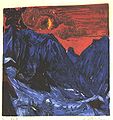Tinzenhorn - Zügen Gorge near Monstein

|
| Tinzenhorn - Zügen Gorge near Monstein |
|---|
| Ernst Ludwig Kirchner , 1919/20 |
| Oil on canvas |
| 119 × 119 cm |
| Kirchner Museum Davos , Davos |
Tinzenhorn - Zügenschlucht near Monstein is the title of a painting by the expressionist painter Ernst Ludwig Kirchner from 1919/20, which depicts the Tinzenhorn and the Zügenschlucht near the village of Monstein in the Davos region. This picture was taken from August 1919 on the Stafelalp and in his studio in the house in the larches below the Chummeralp. The painting is now part of the inventory of the Kirchner Museum Davos . It has the number 578 in the catalog raisonné of Donald E. Gordon .
Background and story
After Kirchner had stayed or settled in Davos with interruptions from 1917 , he painted and drew what he saw and experienced in the area. The Tinzenhorn, which strikingly closes off the landscape to the south, is often the focus of his landscapes. Kirchner stayed on the Stafelalp above Davos Frauenkirch in August 1919 . On August 10, 1919, Kirchner noted in his diary: “I dream a tin picture, in the sunset, only the mountain blue against blue, very simple. Many drawings are there for that. " Just four days later he mentions the picture: “Tinzen tries to 120: 120. Composition succeeded, color and shape completely merged. I want to do it tomorrow. " The picture was created in a relatively short time and was then probably completed in the studio - be it on the Stafelalp, which was used as a summer residence, or in the house next to the larches in the valley floor.
Description and interpretation
The picture is an oil painting on canvas in the format 119 × 119 cm. On the back there is a label from Haus der Kunst München 1962 on the stretcher, one with the number "K 41" on the stretcher cross, and one from the National-Galerie Berlin 1979 on the back box .
Kircher probably painted almost exclusively in his respective studio. As mentioned in his diary and also witnessed by contemporaries, he drew many sketches wherever he was, which he later used as the basis for his pictures. In this picture the view goes in the south-southwest direction to the Tinzenhorn. The cutout, the appearance, the size and the positioning of the Tinzenhorn are emphasized compared to the real view, or combined with other perspectives of the Zügen Gorge. The only human-made work is the Reformed Church of St. Peter von Monstein, also emphasized in its size, as it is almost invisible on site. Kirchner designed a “sublime show of the summit”, which he later included as a symbol of the area in Davos and the mountain world in general in numerous other works, be it paintings, woodcuts or lithographs. In this picture, the Tinzenhorn has its central and probably most spectacular appearance in Kirchner's pictures, but can be found before that in other works and countless sketches. It shows an idealized mountain world with intense colors and light effects, which, however, come very close to the natural experiences of on-site viewers.
Provenance and exhibitions
After its completion, the picture was sold in the Schames art dealer , Frankfurt. Shortly afterwards it was owned by Willy Hahn, Berlin (around 1920). From 1929 to 1937 it was in the collection of the Wiesbaden Museum. Presumably because it was classified as Degenerate Art , it was removed from the collection and transferred to Galerie Ferdinand Moeller , Berlin, for exploitation around 1939 , or was acquired by them. Later it was in a private collection in Cologne and was finally acquired by Lea Steegmann-Morosani, Davos, and donated to the Kirchner Museum in 1991.
The picture was shown in the following exhibitions after the Second World War:
- 1951 in Cologne, Galerie Ferdinand Moeller "Opening exhibition: The old masters of modern art in Germany I", cat. 21st
- 1953 in Lucerne, art museum «German Art. Masterworks of the 20th Century », cat. 50, color plate
- 1960 in Düsseldorf, art association for the Rhineland and Westphalia "Ernst Ludwig Kirchner", cat. 67, color plate
- 1962 in Munich, House of Art «Entartet Kunst. Iconoclasm 25 years ago », cat. 69
- 1988/89 in Davos, Kirchner Museum, cat.-no. 39, color plate
- 2003/04 in Basel, Kunstmuseum Basel , cat.-no. 23, color plate
gallery
The Tinzenhorn in other works by Kirchner:
literature
- Kirchner Association Davos: magazine II - Tinzenhorn. Davos 2000, ISBN 3-9520328-7-5 .
- Kunstmuseum Basel: Ernst Ludwig Kirchner - Bergleben: the early Davos years 1917 - 1926. Hatje Cantz Verlag, Ostfildern-Ruit 2003, ISBN 3-7757-1331-X .
- Ernst Ludwig Kirchner, Tinzenhorn. The timelessness of the hieroglyph. Sketch as a holy engraving, in: Gerd Presler, The Sketch Books. "Ecstasy of first sight". Monograph and catalog raisonné, Karlsruhe / Davos 1996. pp. 119–143, ISBN 3-925521-25-9
Individual evidence
- ↑ a b c d Kirchner Verein Davos: magazine II - Tinzenhorn. Davos 2000, ISBN 39520328-7-5 , p. 16 ff.
- ↑ a b c Kirchner Museum Davos, Catalog of the Collection Volume 1, ed. by Wolfgang Henze, Davos 1992, p. 178f, no.219
- ^ A b Ernst Ludwig Kircher - The early Davos years 1917 - 1923, Hatje Cantz Verlag, Ostfildern-Ruit 2003, ISBN 3-7757-1331-X , p. 43 ff




